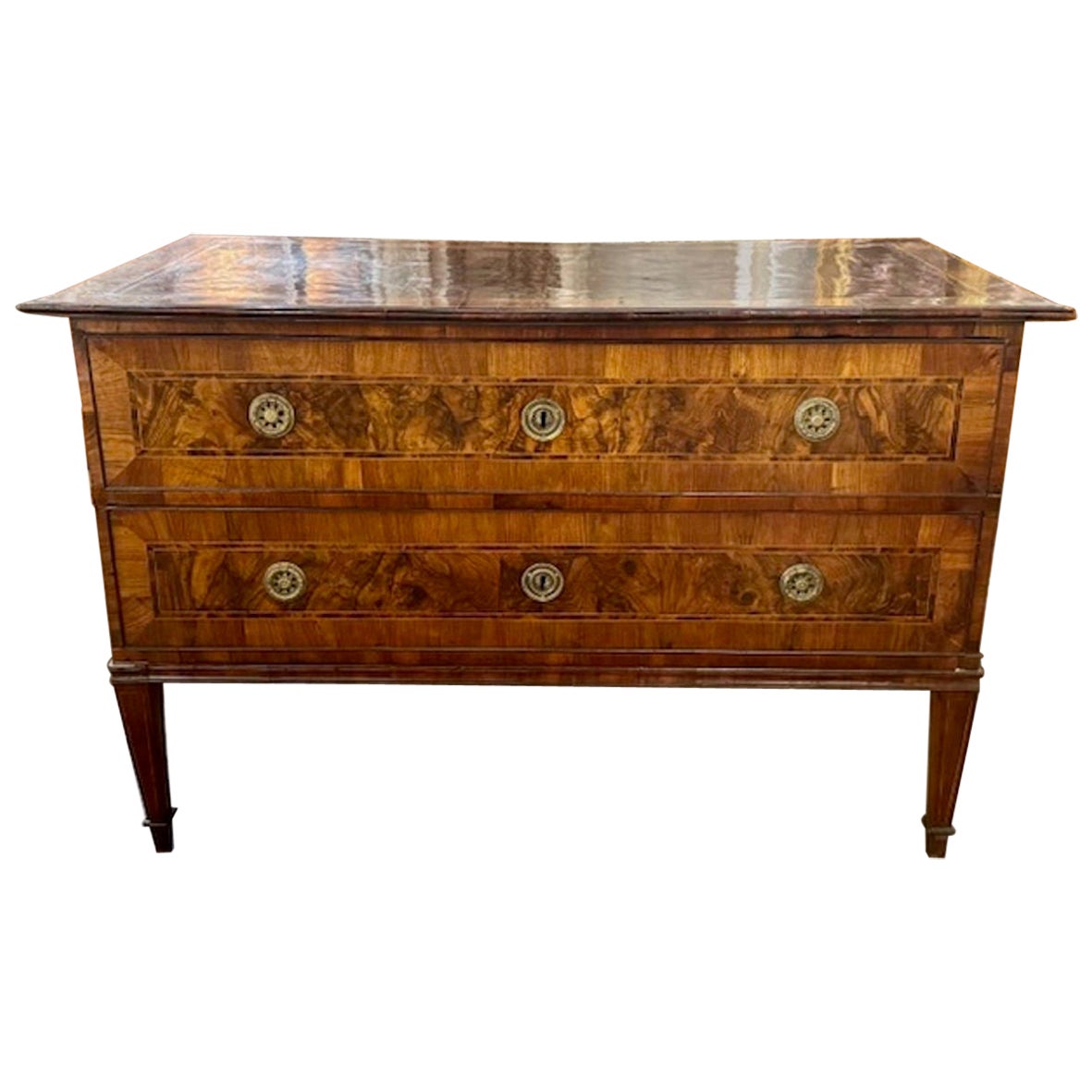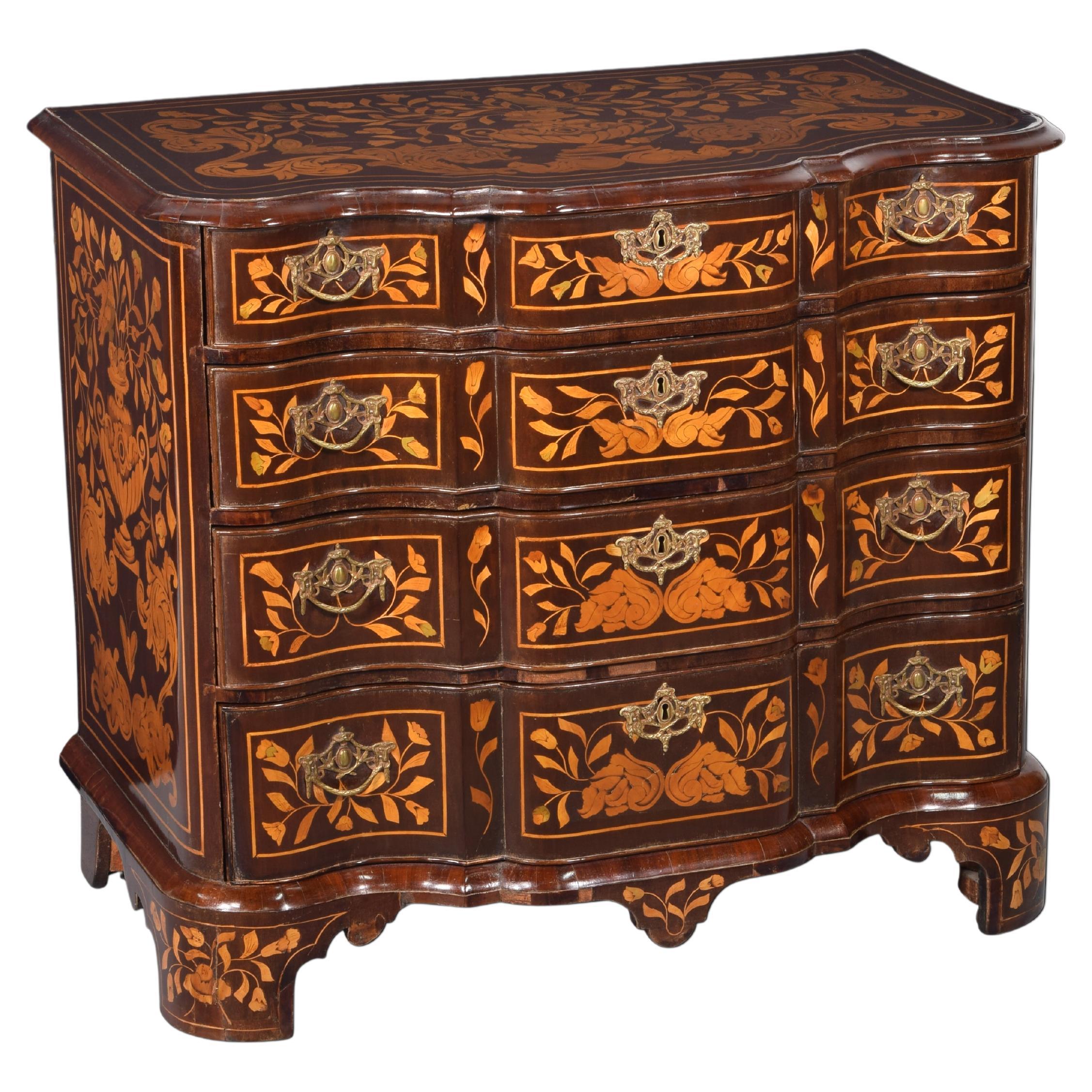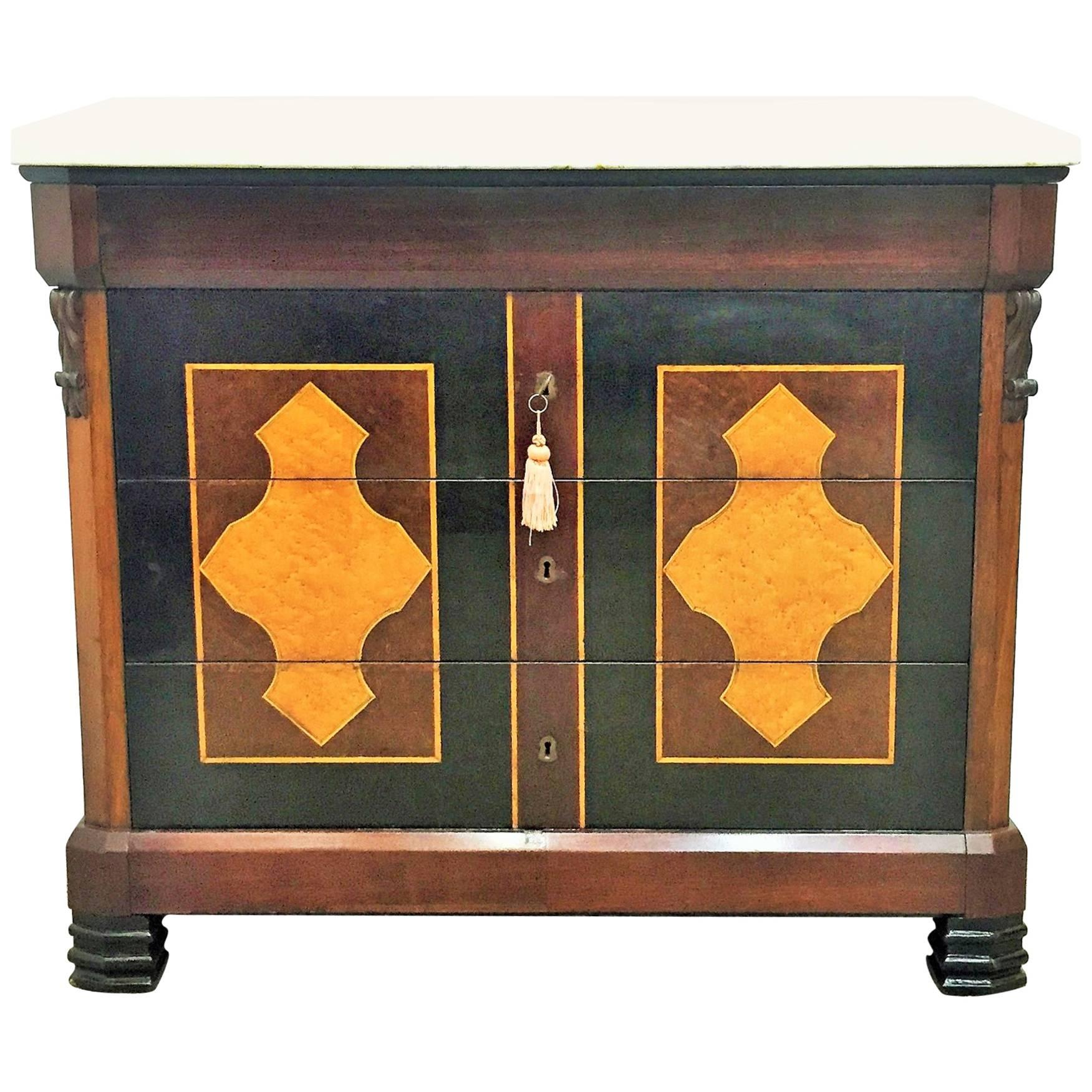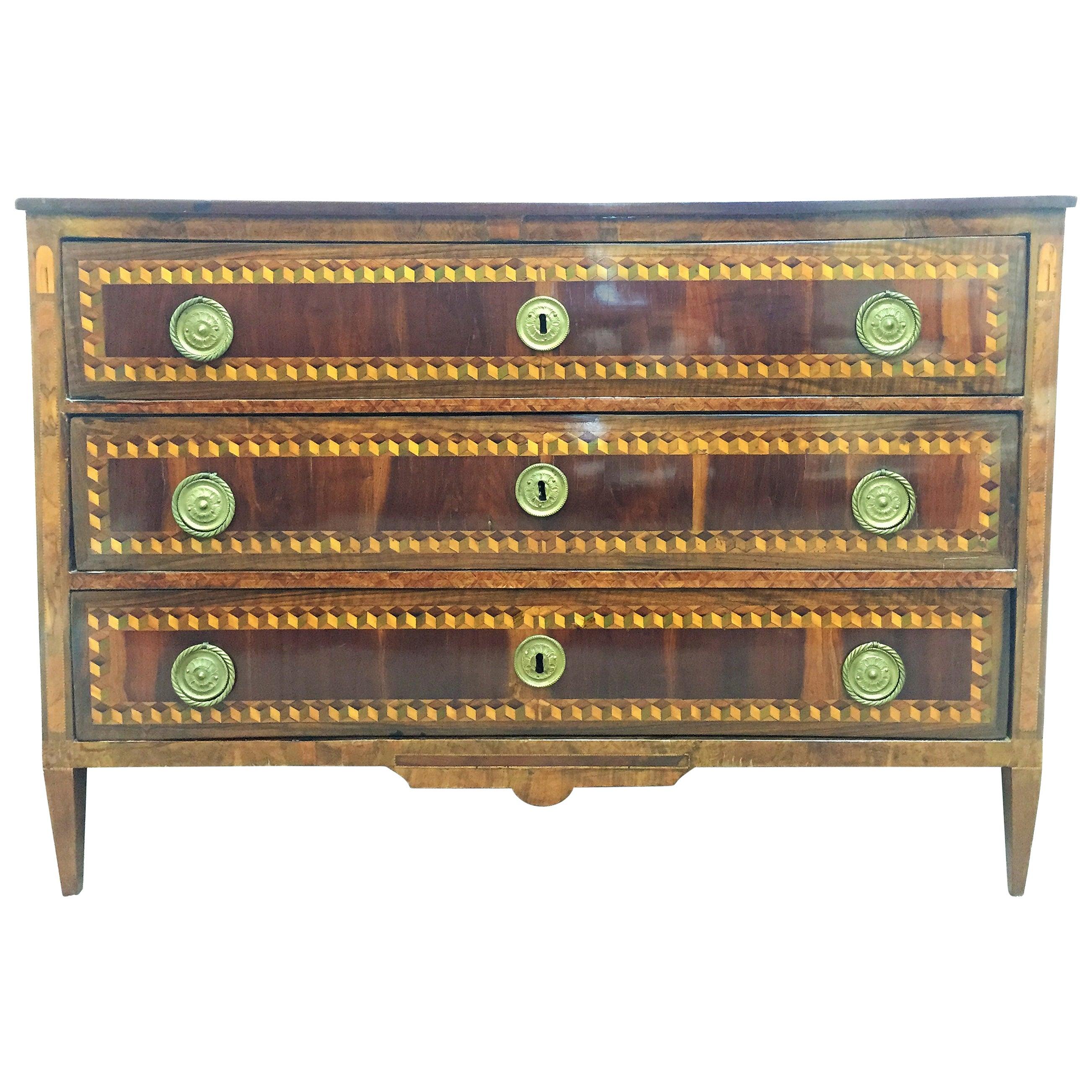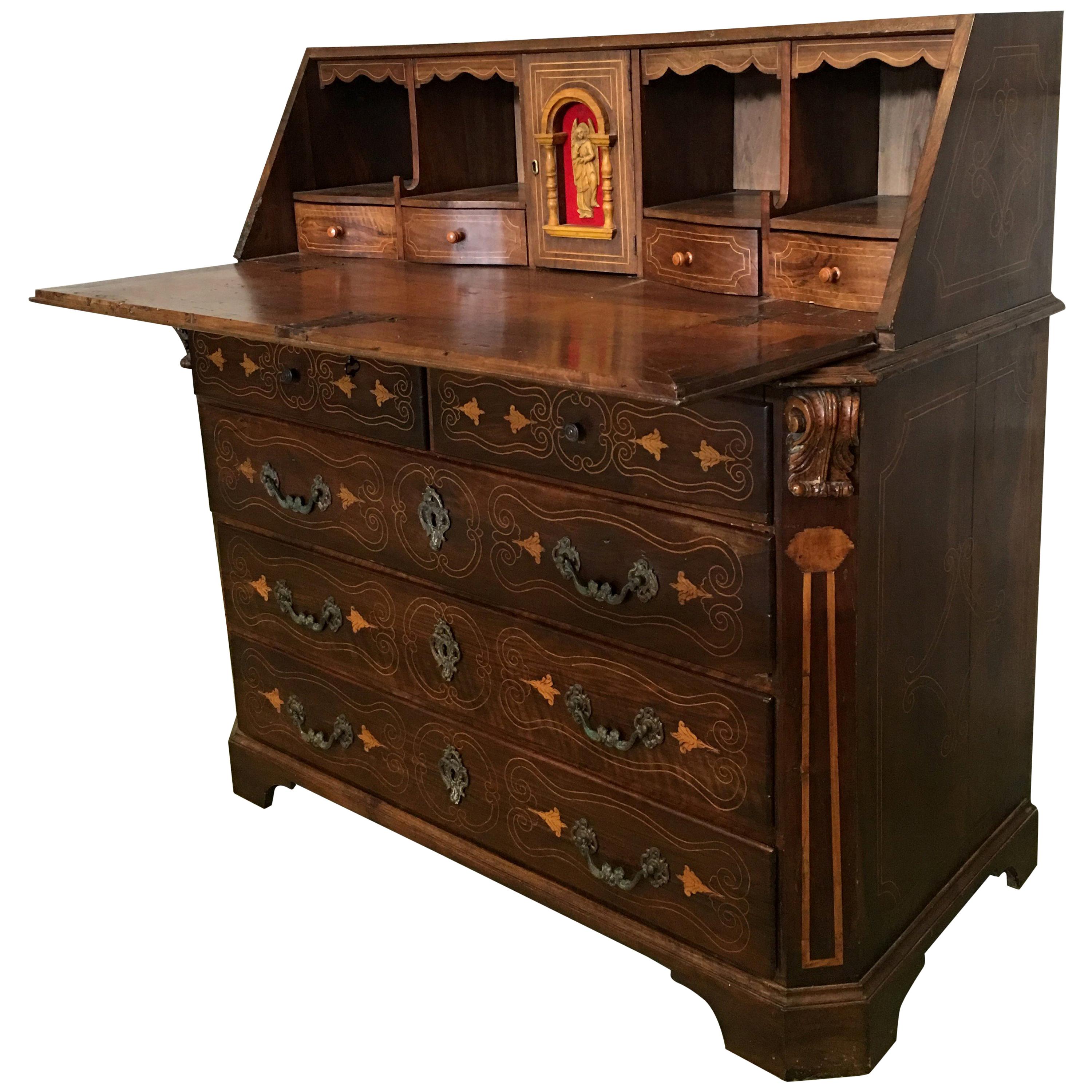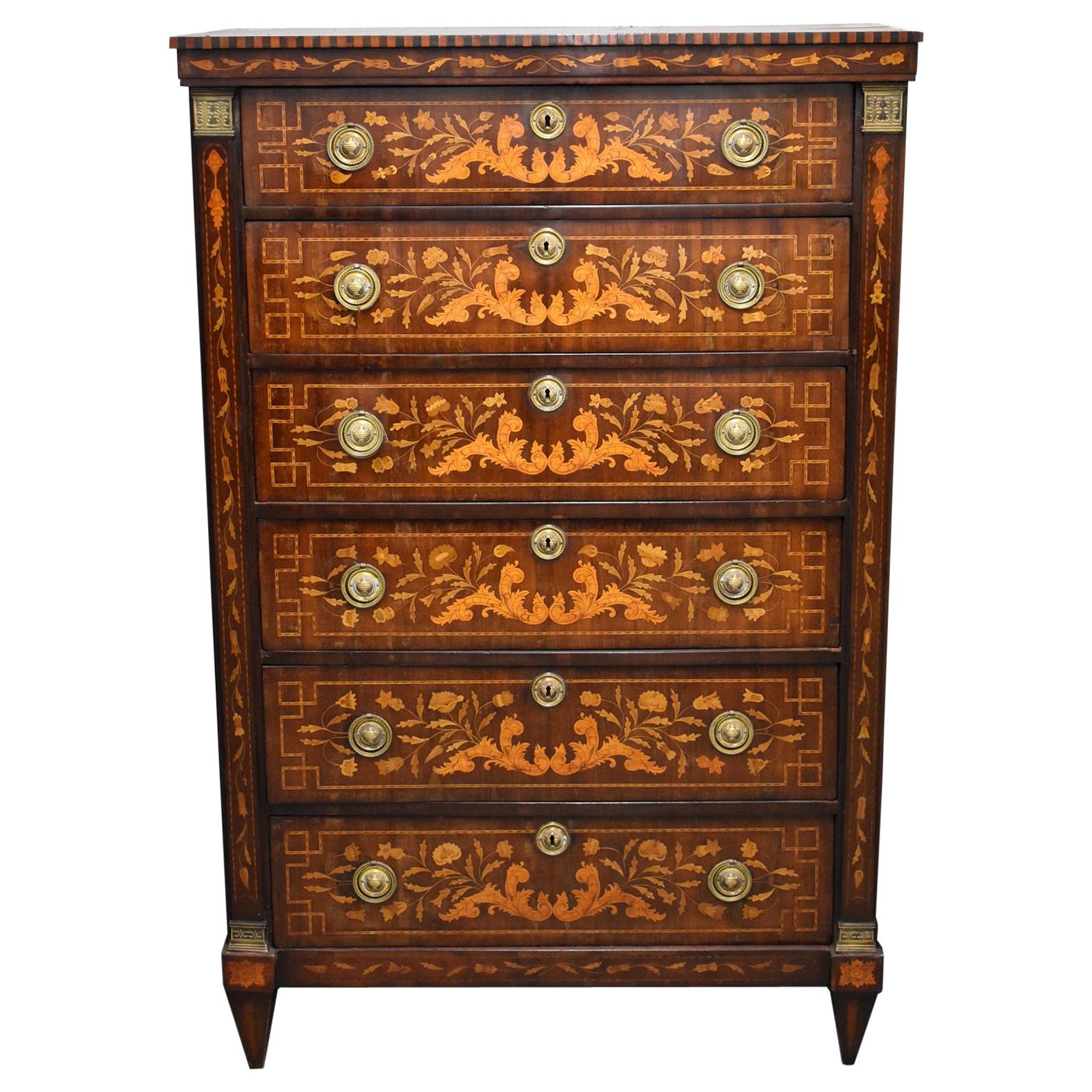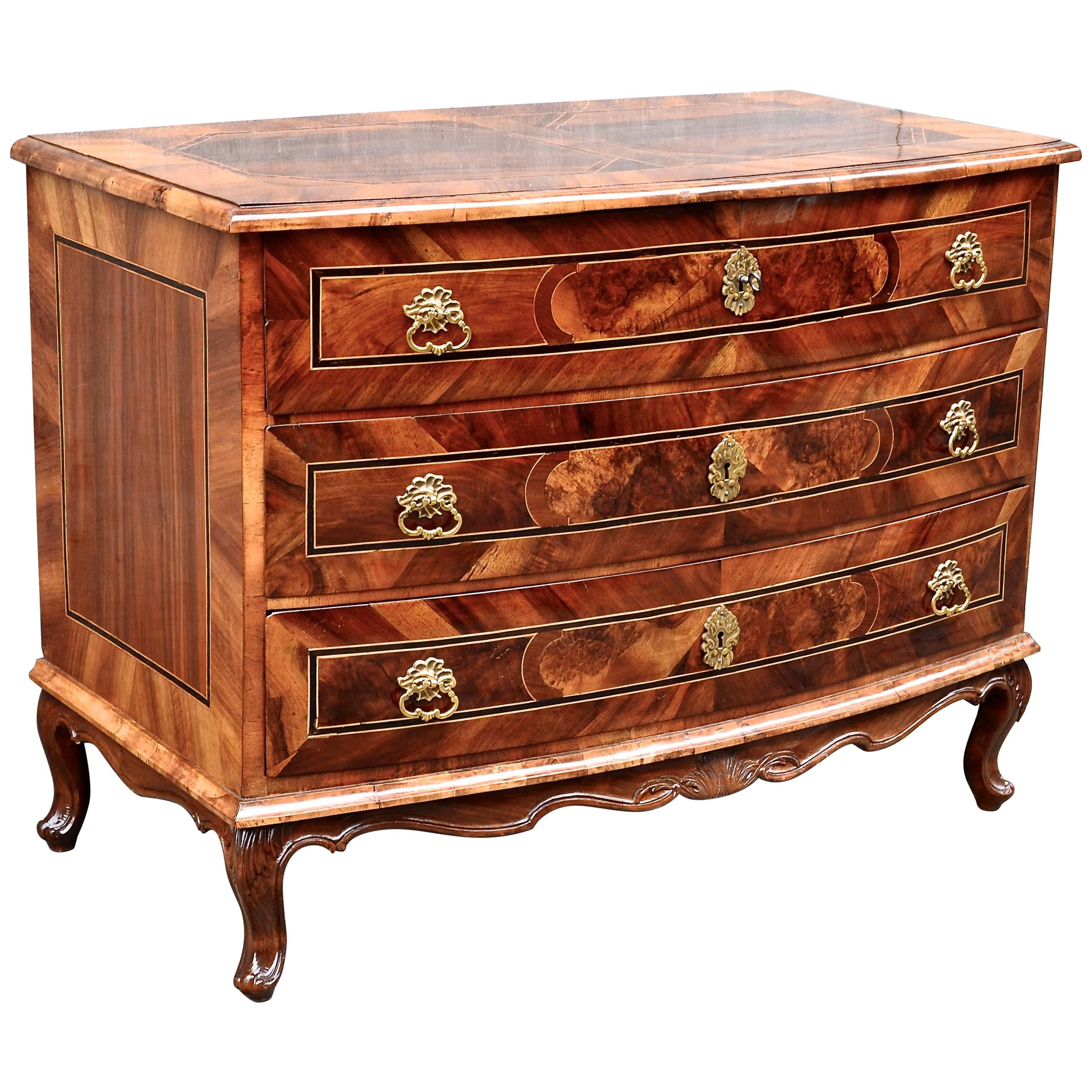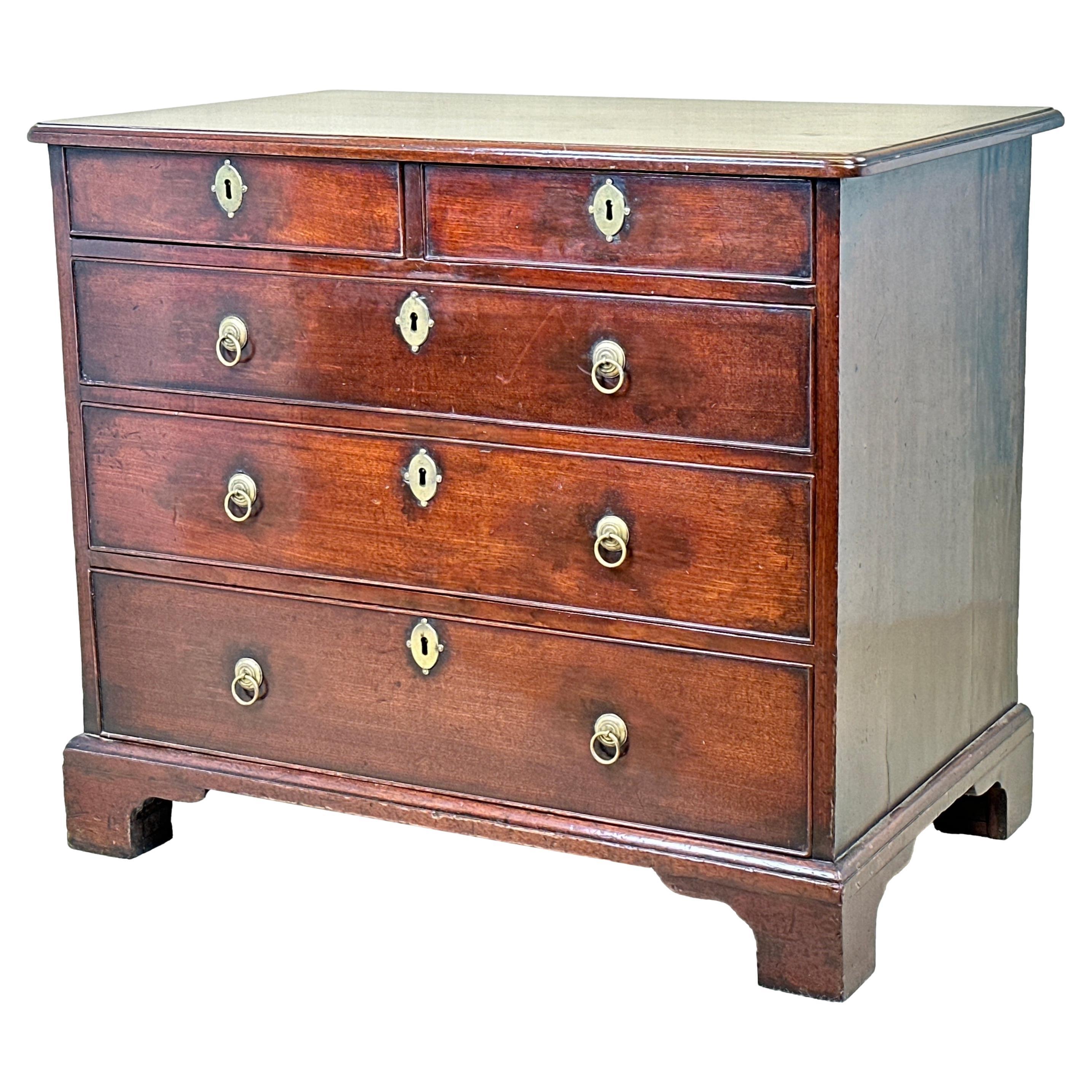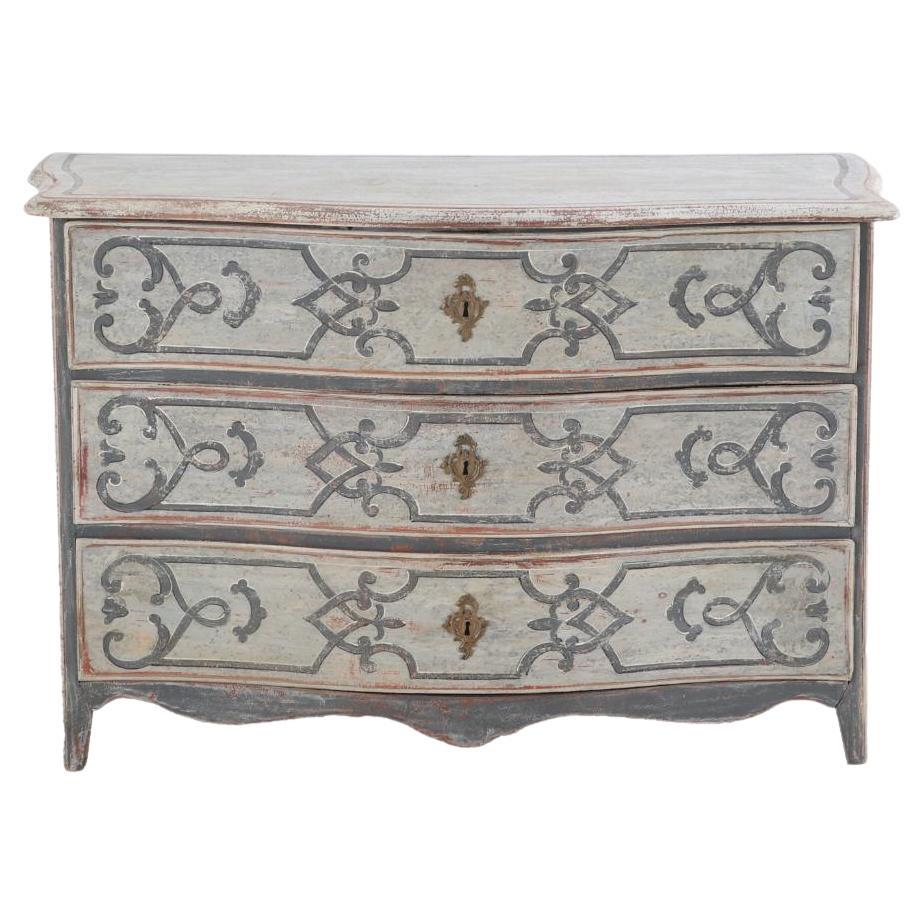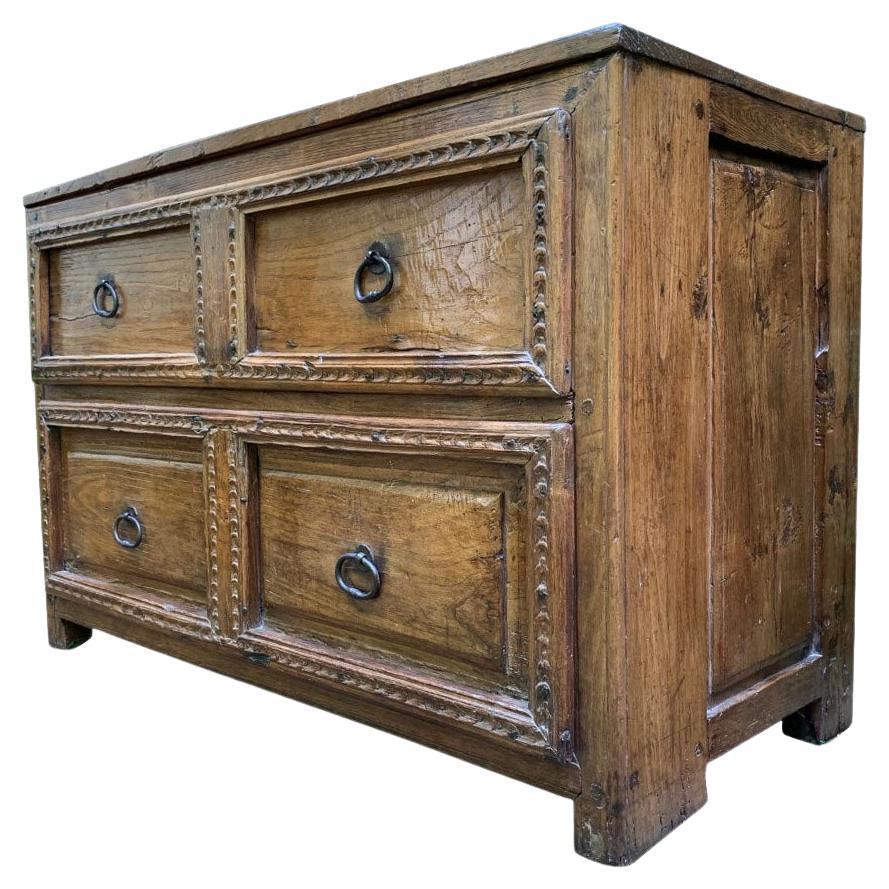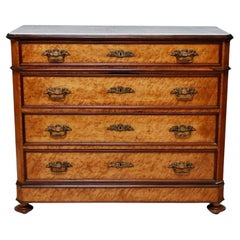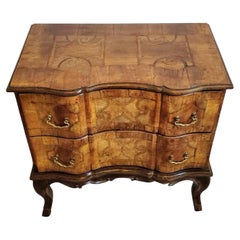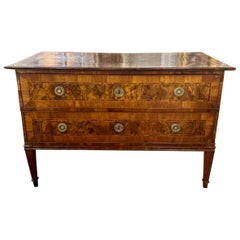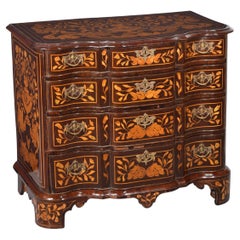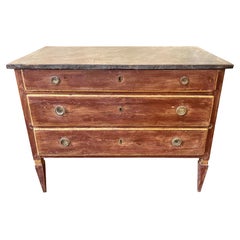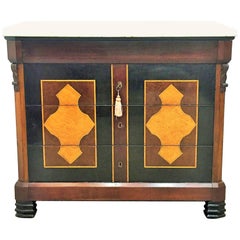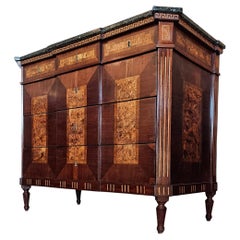
18th Century Spanish Neo-classical Mahogany Marquetry Chest Of Drawers Commode
View Similar Items
Want more images or videos?
Request additional images or videos from the seller
1 of 21
18th Century Spanish Neo-classical Mahogany Marquetry Chest Of Drawers Commode
$4,500List Price
About the Item
- Dimensions:Height: 42.125 in (107 cm)Width: 52.625 in (133.67 cm)Depth: 26 in (66.04 cm)
- Style:Neoclassical (In the Style Of)
- Materials and Techniques:
- Place of Origin:
- Period:
- Date of Manufacture:circa early 1770s
- Condition:Repaired: Expected evidence of old professional restorations, minor later touchups, especially to drawer-fronts. Wear consistent with age and use. Minor losses. Good antique condition w/nicely aged dark rich patina, lustrous sheen, warmth. Retaining character/charm throughout, minor nicks, old repairs, stable age related side splits, all wear consistent w/age & use. Cleaned, waxed, polished, ready for use.
- Seller Location:Forney, TX
- Reference Number:1stDibs: LU5977241963762
About the Seller
4.8
Platinum Seller
Premium sellers with a 4.7+ rating and 24-hour response times
Established in 2013
1stDibs seller since 2021
291 sales on 1stDibs
Authenticity Guarantee
In the unlikely event there’s an issue with an item’s authenticity, contact us within 1 year for a full refund. DetailsMoney-Back Guarantee
If your item is not as described, is damaged in transit, or does not arrive, contact us within 7 days for a full refund. Details24-Hour Cancellation
You have a 24-hour grace period in which to reconsider your purchase, with no questions asked.Vetted Professional Sellers
Our world-class sellers must adhere to strict standards for service and quality, maintaining the integrity of our listings.Price-Match Guarantee
If you find that a seller listed the same item for a lower price elsewhere, we’ll match it.Trusted Global Delivery
Our best-in-class carrier network provides specialized shipping options worldwide, including custom delivery.More From This Seller
View AllRustic 18th Century Italian Louis XVI Period Chest Of Drawers Commode
Located in Forney, TX
A handsome rustic antique Italian walnut chest of drawers commode. circa 1780
Hand-made in Italy in the second half of the 18th century, styled in Neoclassical inspired Louis XVI pe...
Category
Antique 18th Century Italian Louis XVI Commodes and Chests of Drawers
Materials
Brass
Mid-18th Century Louis XV Period Chest Of Drawers Commode Stamped LARDIN
By Andre Antoine Lardin
Located in Forney, TX
An extraordinary Louis XV period (1715-1774) French ormolu mounted tulipwood and kingwood marquetry bombé sauteuse commode by master Parisian ébéniste André-Antoine Lardin. circa late 1740s
In our 40+ years we have not came across a chest of drawers that captures our attention like this one!
Exquisitely hand-crafted in Paris in the mid-18th century, exceptionally executed in opulent and luxurious period King Louis 15th taste, featuring a curvacious serpentine-front bombe-form solid wood case fitted with two drawers, adorned with finely chased, chiseled and gilded bronze doré mounts, including rare and most distinctive sculptural fiolated scroll Rocaille handles, flanking ornate keyhole escutcheons with original key included. In absolutely stunning rare and exotic precious tulipwood and kingwood veneer work with striking warm rich highly figured grain patterns, elegant floral marquetry inlays and fascinating early sunburst panels. Topped with the original serpentine shaped Brèche de Médous marble-top with stepped molded edge. The Breccia de Médous is extracted in the towns of Médous and Asté, near Bagnères-de-Bigorre in the Hautes-Pyrénées. This dramatic breccia is composed of angular elements of contrasting colors ranging from black to yellow to gray creating a bold but subdued visual display.
Signed, retaining the original LARDIN blind stamp to top proper-right rear post underneath marble. André-Antoine Lardin (1724-1790) is a celebrated Master Cabinetmaker, earning maître in 1750, and particularly respected for his extraordinary woodworking veneer - marquetry work.
- PROVENANCE / ACQUISITION:
From the important collection of Loyd-Paxton, Dallas, Texas.
Property from the magnificent Estate of Mr. and Mrs. Robert Morris Graham Sr., El Paso, Texas, but also with homes in Dallas, Texas and Pebble Beach, California.
Acquired from the highly reputable auction house Heritage Auctions, Dallas, Texas.
2024 Furniture & Decorative Art Featuring The Collection of Mrs. Henry Ford II Signature Auction Catalog #8167
Loyd Paxton Gallery, Dallas, Texas.
With one of the finest collections in the world and prominent customers to match, including Sir Elton John, Truman Capote, Saudi Prince Faisal, and the Sultan of Brunei. Rare French antiques from Loyd-Paxton made their way into Versailles when it underwent renovations, and the Metropolitan Museum of Art in New York purchased furnishings, including a dazzling Louis XIV Boulle desk that had been owned by the Sun King himself.
Betty Jo Graham might not hold celebrity status but her remarkable life and many contributions to American history and the arts community of El Paso, Texas, make her deserving of the limelight nonetheless.
Affectionately known to her friends as BJ, led a remarkable life that intertwined a deep passion for music with significant contributions to her community and country. BJ embarked on her vocal journey at the age of 12, studying under the esteemed Mini Ferguson Owens at the University of Wichita. Her pursuit of musical excellence continued in the same institution, where she later attended college.
BJ's life was not solely dedicated to music; she also played a vital role in American history. During the tumultuous times of World War II, she contributed her skills to the Cessna AT-17 training program, a crucial effort in preparing pilots for combat. She worked as an electrical wiring diagram analyst for Boeing Engineering Development on the iconic Enola Gay project in 1956.
BJ's heart always remained with music. She continued to refine her vocal skills with notable figures such as Maude Douglas Tweedy in New York City and John Charles Thomas in Apple Valley, California. Her love story with Robert Morris Graham Sr., whom she married in 1975, was filled with shared adventures and travels across the globe, living in places from Dallas, Texas, to Pebble Beach, California, and El Paso, Texas.
As a trustee of the El Paso Symphony Orchestra and a board member of the El Paso Symphony Youth Orchestra and El Paso Pro-Musica, she played a pivotal role in nurturing the musical landscape of her community. Her support extended to various causes, including the El Paso Opera, Holocaust Museum, Museum of Art, and many more, showcasing her belief in the transformative power of art and culture.
Betty Jo Graham's journey through life reflects a profound dedication to her passions, community, and the arts. Her legacy, marked by her music, history, and philanthropy contributions, inspires and impacts many, ensuring that her melodious spirit will be remembered and cherished for future generations.
After traveling the globe and living in cities across the country, Graham and her husband, Robert Morris Graham Sr., eventually settled in El Paso, where she served as a trustee of the El Paso Symphony Orchestra and a board member of the El Paso Symphony Youth Orchestra and El Paso Pro-Musica. Though Graham had a lifelong passion for music and played a pivotal role in nurturing the musical landscape of her community, her philanthropy extended to various causes, including the El Paso Opera, El Paso Holocaust Museum and El Paso Museum of Art, showcasing her belief in the power of art and culture.
A patron of the arts, Graham was also a collector of fine jewelry, with a particular fondness for eye-catching, statement-making rings, necklaces, earrings and more, and Heritage was honored to present Property from the Estate of Mrs. Betty Jo “B.J.” Graham as part of its Spring Fine Jewelry Signature Auction.
Inscription to placard on reverse:
FROM THE COLLECTION OF LOYD-PAXTON DALLAS, TEXAS
Signatures:
Original blind stamped LARDIN to top of rear post. Bronzes not removed to inspect for foundry marks.
- DIMENSIONS: (approx)
33" High, 42" Wide, 20.75" Deep
- CONDITION REPORT:
Overall a superb example, especially considering its nearly 300 years old. Beautifully aged warm patina, antique wood glow and lustrous sheen. Strong, sturdy, stable, structurally sound. Evidence of restorations, likely by Loyd-Paxton, including high-quality bespoke upholstered drawer lining. Typical wear commensurate with age, use, handling and exposure, including minor nicks to edge, age splits scattered throughout body, expected antique character and charm. Marble top is in great shape. Accompanied by two working keys.
Overall outstanding presence, delivered cleaned, waxed, with hand rubbed polished patina, ready for immediate use and generational enjoyment!
- INTERESTING ADDITIONAL INFORMATION:
This elegant commode typifies the fashion for furniture mounted with exotic and rare woods, exquisite marquetry-work, and decadent Rococo bronzes.
Andre Antoine Lardin, also known as N.B. Lardin was born in 1724 and died on 10 August 1790. He held his master's title from 1 July 1750 and was particularly respected for the exceptional quality of his veneering / marquetry. A well known and regarded maître ébéniste, Lardin’s career is somewhat thinly documented, most likely due to the upheaval and record destruction during the Revolution, notably when the guilds in Paris and elsewhere were abolished in 1791.
Lardin worked for various marchand-mercier (furniture dealers) and probably also for a private clientele. He ran his workshop first in the Rue de Charenton and from 1770 in the Rue Saint-Nicolas. His two sons, André Antoine II and Louis François, worked with him for some time and the second-named became his successor in the Rue Saint-Nicolas.
Lardin is known to have worked for the marchands André-François Carré, this superb commode having almost most certainly been commissioned through the intervention of one of these fashionable dealers.
The marchand-mercier André-François Carré, is recorded rue Froidmanteau, "Magasin de glaces, porcelaine ébénisterie et curiosités pour les cabinets d'histoire naturelle." Carré also worked with two vernisseurs (vernis Martin): Porchon and Prévost.
All of Lardin's furniture is classic in form and decor, well crafted and mostly veneered in rosewoods or violet wood. Lardin worked in the taste of the time with geometric patterns, cartouche fields and simulated fluting. Furniture with elaborate inlays such as birds, trophies, urns, landscapes, or flowers and sunburts such as this stunning example appear more rarely.
The stamp JME stands for Jures Menuisiers Ebeniste and notes the guild affiliation of the master. The Corporation des Menuisiers-Ébénistes was a French craft guild which was concerned with the profession of woodworking. Some JME stamps are worn down from the marble slab over the years and no longer apparent, but in this case lacking the JME stamp is likely indicative of work made prior to reaching maître ébéniste (master cabinetmaker), denoting an early and exceedingly scarce example.
Eighteenth century French furniture...
Category
Antique Mid-18th Century French Louis XV Commodes and Chests of Drawers
Materials
Breccia Marble, Bronze, Ormolu
19th Century Italian Bird’s-Eye Maple Chest of Drawers Commode
Located in Forney, TX
A stunning fine quality antique, circa 1860s/1870s Italian chest of drawers commode.
Hand-crafted in Italy in the third quarter of the 19th century, influenced by Napoleon III Se...
Category
Antique Mid-19th Century Italian Napoleon III Commodes and Chests of Dra...
Materials
Carrara Marble, Brass
18th Century German Baroque Sauteuse Commode
Located in Forney, TX
A unique signed original Baroque Sauteuse commode from the 18th century. Exceptionally executed, this elegant German mid-sized walnut cabinet presents with absolutely beautiful inlay works, including patchwork marquetry, scrolled inlay and fine inlayed thread work that provide this unique period commode a fine touch of luxury. Finished in Rococo Louis XV taste, the artisans carefully selected highest quality, warm, rich woods, including burled walnut, fruitwood, olive wood, burl maple and various other exotic woods. Having a serpentine shaped top and case fitted with two gorgeous curved drawers, each with parcel-gilt brass pulls and interior paper lining marked Fabrication Allemande. Both the case and drawers have been joined by hand carved dovetail joinery. Resting over a wonderfully shaped and hand carved solid walnut base, accented by simple scroll running ornamentation carvings along the apron, gracefully rising on high cabriole legs, terminating on hoof feet. Signed/Stamped, interior, legible.
It is one of the pieces of our extensive collection richer in inlays, very warm and complex, a feature that made us literally fall in love at first sight of this beautiful antique dresser...
Category
Antique 18th Century Baroque Commodes and Chests of Drawers
Materials
Fruitwood, Maple, Olive, Walnut, Burl
19th Century Danish Chest of Drawers
Located in Forney, TX
A monumental Danish chest of drawers commode from the 19th century. The magnificent, handcrafted Scandinavian antique having molded cornice, over case fitted with five drawers, all w...
Category
Antique 19th Century Commodes and Chests of Drawers
Materials
Bronze, Ormolu
Antique French Transitional Banded Chest Of Drawers Commode
Located in Forney, TX
A fine French antique, circa 1900, Transitional Louis XV - XVI style marble-top chest of drawers commode.
Hand-crafted in France in the early 20th century, exceptionally executed in 18th century Regence taste, of excellent quality, craftsmanship and solid wood construction, featuring stunning matched veneer and banded serpentine shaped case, fitted with three graduated dovetailed drawers. Each drawer affixed with original patinated gilt brass Rocaille pulls flanking ornate complimentary escutcheons, over chiseled gilt bronze mounted scalloped apron, rising on tapered French transition legs, ending in sabots. Topped with the original rouge red marble...
Category
Early 20th Century French Louis XV Commodes and Chests of Drawers
Materials
Marble
You May Also Like
18th Century Italian Neo-Classical Commode
Located in Dallas, TX
The 18th Century Walnut Italian Neo-Classical Commode is a vintage piece of furniture that exudes elegance and sophistication. This commode features a beautiful inlaid pattern and a ...
Category
Antique Late 18th Century Neoclassical Commodes and Chests of Drawers
Materials
Walnut
Dutch Marquetry Chest of Drawers or Commode, 18th Century
Located in Madrid, ES
Dutch marquetry chest of drawers. Century XVIII.
Requires restoration.
Chest of drawers with four front drawers with key lock and ...
Category
Antique 18th Century European Rococo Commodes and Chests of Drawers
Materials
Other
18th Century Italian Painted Neo-Classical Commode
Located in Dallas, TX
Late 18th century Italian painted neo-classical style commode. Rusty red color with a painted grey top. A handsome piece!
Category
Antique 18th Century Italian Neoclassical Commodes and Chests of Drawers
Materials
Wood
$5,440 Sale Price
35% Off
Chest of drawers. Italian Commode, 18th Century
Located in Miami, FL
Fine 18th century Italian five-drawer walnut commode with inlay and carved giltwood detail, with a figured marble top.
Category
Antique Mid-18th Century Italian Neoclassical Commodes and Chests of Dra...
Materials
Walnut
18th Century Spanish Walnut Marquetry, Chest of Drawers with Flap
Located in Miami, FL
18th century Spanish walnut marquetry bureau.
This is an exquisite antique Spanish bureau, circa 1780 in date this elegant bureau will soon become th...
Category
Antique Late 18th Century Spanish Colonial Commodes and Chests of Drawers
Materials
Maple, Walnut
$8,100 Sale Price
25% Off
18th Century Louis XVI Marquetry Commode or Chest of Drawers with Tulipwood
Located in Miami, FL
18th century Louis XVI marquetry commode or chest of drawers with tulipwood inlay veneer and oak and pine as secondary wood.
Category
Antique 18th Century Spanish Neoclassical Commodes and Chests of Drawers
Materials
Bronze
Recently Viewed
View AllMore Ways To Browse
Grand Server
Antique Spanish Commode
Oversize Dressers
French Empire Dresser
Spanish Style Sideboard
Empire Mahogany Dresser
Buffet Marble Inlay
Burlwood Mahogany
Italian Burl Wood Dresser
18th Century Marble Top Dresser
Antique Spanish Sideboard
42 Wide Dresser
Italian Empire Commode
Greek Key Buffet
Burl Wood Cube
Bourbon Cabinet
Greek Key Dresser
Spanish Server
